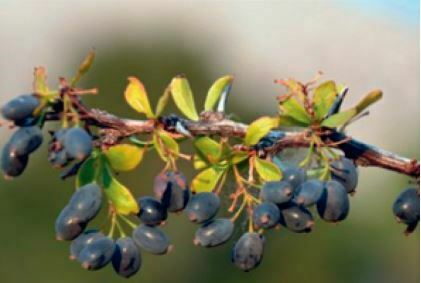Berberis crataegina DC. is a shrub-shaped plant of the genus Berberis, which is distributed in the northern temperate regions of the world in Southern Asia, including the northeastern region of the United States, many parts of central and southern Europe and the northern region of Pakistan.
However, it is reported that there are about 500 different species in the world. There are four species of this genus naturally in Turkey and they are reported as Berberis vulgaris, Berberis integerrima, Berberis crataegina and Berberis cretica.

Berberis crataegina DC., which belongs to the Berberidaceae family and the Berberis genus, spreads naturally in Turkey (usually outside of Western Anatolia) and Iran.
This plant has dark reddish brown young shoots and its body is thorny. The distinguishing feature of this species from other species is that the leaves are usually longer than the spines.
The flowering time of Berberis crataegina DC. is in May-June. It does not have black lenticels on young stems, and the leaves are generally 1-4 cm long with coarse-toothed or entire edges. The flower bodies are 1-3 cm tall and have 6-15 flowers.
The elliptical-shaped fruits are dark red-brown before ripening, black when ripe and have a slightly sour taste. Berberis crataegina DC. fruit contains one or more seeds.
On some trees, Berberis crataegina DC. fruits grow like a bunch of grapes, while on others, it can grow singly.
Although Berberis crataegina DC. fruit has been known for a long time and used in different ways, it has a potential that can be considered new in scientific research and can be the subject of many further studies.
Berberis crataegina DC. fruits have a slightly sour taste and contain high amounts of anthocyanins and vitamin C, tannins and organic acids. All parts of this plant (fruit, root, branch, flower and leaf) are often used in traditional medicine to treat various diseases.
Studies on the fruit, leaves and roots of this plant continue intensively. In some studies on Berberis crataegina DC. fruit, phenolic compounds; chlorogenic acid, syringic acid, gallic acid, sinapic acid, caffeic acid, apigenin, cinnamic acid, quercetin, p-coumaric acid and trans-ferulic acid were detected.
It can be said that Berberis crataegina DC. fruits are good antioxidants and rich in phenolic substances. It has been determined that berberine (BBR) alkaloid and its extracts in B. crataegina have strong antifungal and antidiabetic activity.
Health Benefits of Berberis crataegina DC.
It has been reported that berberine and various other alkaloids, which are the active substances found in the root of the Berberis crataegina DC. plant, are antipyretic, anti-inflammatory and effective against boils, prevent the development of bacteria, and have therapeutic effects on diseases such as hemorrhoids, jaundice, bronchitis and colds.
It is also known that the ointment obtained by mixing the ash created by burning Berberis crataegina DC. roots and unsalted butter is good for all kinds of wounds.
Berberis crataegina DC. fruit is generally consumed by the local people where it grows, using traditional methods specific to the region. Berberis crataegina DC. fruits are widely used in different areas of Turkiye to treat colds, rheumatism, blood pressure lowering, blood-forming, diarrhea, constipation, jaundice, hemorrhoids, yeast, diabetes, gallbladder, stomach and intestinal disorders, cardiovascular and gynecological diseases.
It is also known that the fruit of the plant is eaten in case of diabetes, and in some regions, its roots are boiled and the boiled water is drunk on an empty stomach in the morning and used to treat diseases such as diabetes, kidney pain and jaundice.
In addition to the fruits of this plant, its leaves and roots are also evaluated in different ways. The leaves of this plant; It is used as a blood pressure reducer and expectorant.
The flowers of Berberis crataegina DC. are used in the treatment of jaundice and hemorrhoids. The fruit is not only used directly by the people of the region where it is found but also drinks (compote, fruit syrup, etc.), jam, marmalade and desserts are made from it. It is also reported that it is added to soup and bulgur pilaf to add flavor.
It is seen that the consumption of this wild fruit, which is considered to be extremely promising in terms of its antioxidant content, phenolic components and antimicrobial potential, can increase and increase the diversity in production by developing cultural production methods and introducing it to the whole world.
References;
Baytop, T. (1999). Herbal treatment in Turkey (past and present). Nobel Medicine Publisher, Istanbul.
Karabulut, A. (2018). Berberis vulgaris L. and Berberis crataegina DC naturally found in Bayburt province. Biochemical characterization of wild fruits. Master Thesis. Bayburt University, Institute of Science and Technology, Department of Food Engineering,Bayburt.
Eroglu, A.Y. (2019). Determination of some physicochemical properties and antioxidant and antimicrobial capacity of wild Berberis vulgaris L. and Berberis crataegina DC. fruits. Master Thesis. Bayburt University, Institute of Science and Technology, Department of Food Engineering, Bayburt.
You may also be interested in this article; Barberries (Berberis vulgaris); Overview and Health Benefits
Be First to Comment